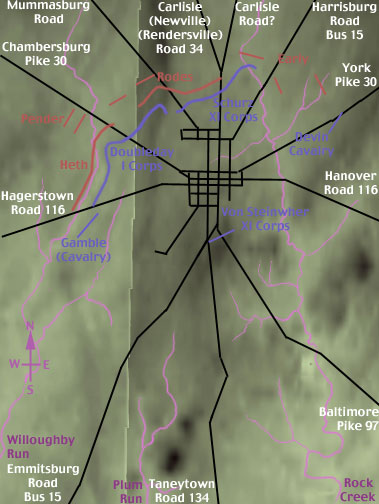 |
|
Based on Map 5, Coddington, The Gettysburg Campaign |
Confederate General Forestt briefly described one of the basic principles of war. "Get there firstest with the mostest." This summarizes the first day at Gettysburg. Ewell and Hill arrived with four of the ANV's nine divisions, roughly 45% of Lee's infantry. A fifth division arrived late in the day, but was held in reserve by Lee. The Union could not hold with two of their seven corps, about 29% of the slightly more numerous northern infantry.
 |
|
Based on Map 5, Coddington, The Gettysburg Campaign |
The Union fought well for most of the day. General Buford with dismounted cavalry delayed Hill long enough for the Union First and Eleventh Corps to come up. The Union First Corps was one of their best, and stood well for a time. The Eleventh was not one of the Union's best. Their collapse led to a general and costly Union retreat through the town. Granted, being outnumbered and flanked, the retreat was likely regardless of the quality of the Eleventh. Union reserves on Cemetery hill served to break the retreat.
In general over the three day battle, US used terrain well, fought on the defensive, while the CS forces tried but generally failed to turn the Yankee's flank. On the afternoon of July 1, Early did turn the XI Corps flank. There was a band of trees running along Rock Creek. Early was able to get Hays' and Avery's brigades in the XI Corps right and rear. This forced the XI Corps to break. This uncovered the I Corps right, thus the I Corps had to follow.
The Union battle line is comparatively spread out. Two army corps are covering a battle line close in length to the July 3 Big Round Top to Spanglers Spring fish hook line. On July 3, six corps held a line roughly as long but with far stronger terrain. The closer one packs the line together, the stronger the line, but the easier it is for an opponent to reach the flank.
During the morning fighting on July 1, the I Corps treated Heth roughly. Note the ridges and streams are running north-south in the fields north of Gettysburg. Thus, a battle line facing east or west can use the terrain well. Hill, approaching across the ridges, had a difficult fight. Ewell's approach from the north was 'with the grain' of the terrain. The XI Corps could not use the ground as effectively as the I Corps. While the XI Corps was not highly regarded after being routed twice, both here and at Chambersburg they were outnumbered and flanked. I would question their courage an honor less than their scouting and skirmishing doctrines. They were twice victim of Southern flanking movements.
It is alleged that if Stonewall had been present, he would have pressed the attack late on July 1, and driven the Union off the Cemetery and Culp's hills. It is possible that if Stuart had been screening and scouting, Lee would have concentrated sooner. Instead of a meeting encounter resulting in tactical victory, would Lee have had a chance to thoroughly crush one of Meade's wings?
As is, neither happened. Meade kept his three wings in supporting distance of one another, anticipating a meeting engagement by one wing or another. He pushed for more rapid marches than was the Army of the Potomac's norm. By the morning of July 2, six of the seven Union corps were at Gettysburg.
Lee's July 1 orders to Ewell and Hill were somewhat ambiguous. They were encouraged to attack, but were not to bring on a general engagement. How could one hope to seriously hurt two corps of infantry without bringing on a general engagement? The South clearly achieved a tactical victory. However, a general engagement resulted.
While the South was maneuvering against the northern army, the North was maneuvering to allow concentration on high ground. There is no doubt the North was defeated on July 1. They suffered a tactical loss. On the other hand, they achieved their strategic objective. They had protected the high ground. They were concentrated by the morning of July 2, and yielded Lee the initiative. One might contend the battle had already been won. The stronger army held the stronger position. The North would have to make a serious error to allow the South to win. General Sickles' movement forward out of his "hole" was just such an error. The Rebels were not quite able to take advantage of the error.
On the morning of July 2, Longstreet examined the Union position, and tried to persuade Lee to leave the field. Longstreet recommended circling well around the Union south flank. This would threaten Washington, forcing the Union to leave the high ground. By Longstreet's account, Lee was committed to defeating those people where they were. "No; they are there in position, and I am going to whip them, or they are going to whip me."
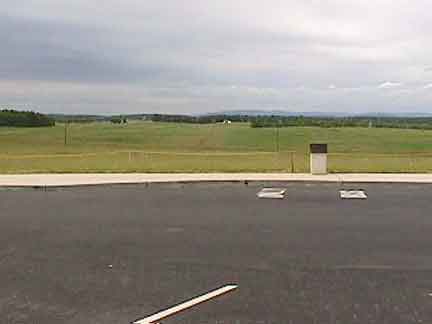 |
|
With the Grain From the Peace Memorial, down the length of the Union positions. Rodes' Confederate division advance from the Peace Memorial's position down this field. |
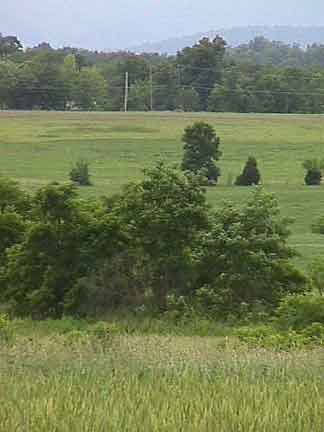
From the RR Cut, towards the
Hill's approaching Confederates
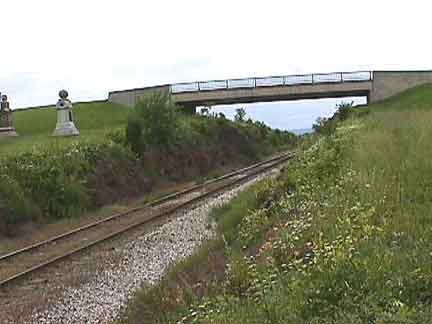
The bridge is modern.
The cut illustrates the height of a typical Gettysburg
ridge,
enough to hide an infantry formation and provide cover,
but does not block movement.
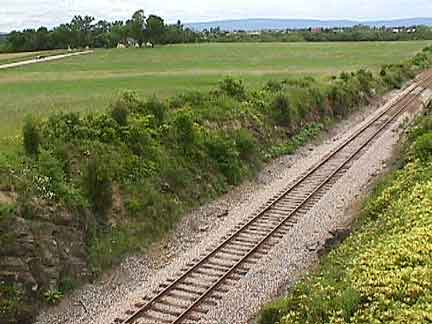
The Chambersburg Pike and next ridge
are visible in the background.
The rail road cut changed hand several times during the fighting. After the Confederates took it the first time, it was used to provide cover in firing towards the Chambersburg Pike. However, the Union flanked the position, and were able to fire up the length of the cut. This caused many casualties and forced a Confederate surrender. Later in the day, the Confederates regained the position, and the entire field.
 |
|
The row of trees blocks where most of the XI made their stand. The trees to the right run along Oak Ridge, and block view of the I Corps field. The Peace Memorial is off to the right of this picture, on the I Corps field. Ewell's Corps attack from this angle, and from the left. This is a wide pan view, four pictures spliced together. |
Next: The View from Cyberspace